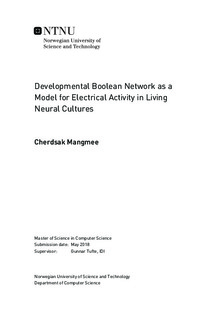| dc.description.abstract | Technological advancement through the last century have made it possible to not only culture neurons in vitro (in glass outside the body), but also to a certain degree record and control their development. Micro-electrode array or Multi-electrode array (MEA, abbreviation for both) is one such technological advancement that allow for intra-cellular voltage spike recording and stimulation of cultured neurons. Through the electrodes mounted on the floor of the culturing chambers, spiking activities from the neurons can be captured, and stimuli can be passed to them through these bidirectional electrodes. In this thesis a customised random Boolean network (RBN) model have been made, to model the change in electrical activities of developing in vitro neural cultures.
\newline
\newline
Through the NTNU Cyborg initiative, MEAs with 60 electrodes is set up and available for experimentation.
For this thesis, 4 neuron cultures were set up and recorded from initialisation and over a period of 18 days (only data from 15 days acquired). Due to the number and spatial placement of the electrodes, only a subset of the neuron culture activity is available through the recordings. Since the neurons tend to form clusters and connect to other clusters through their axon-pathways, we try to model this behaviour with our customised RBN model. In short the RBN is placed in a grid in the same fashion as the MEA. Furthermore a restriction is placed on the network, such that each node's chance of connecting to other nodes further away in the grid grows with time. We call the probabilities restricting each nodes connection possibilities the \textit{distant connect} probabilities. These probabilities is governed by the parameter $\sigma$, where a $\sigma$ = 0 only allows the nodes to connect to themselves, while greater values allows for connection to nodes further away.
\newline
\newline
Unfortunately no direct comparisons between the systems were done, due to issues with the neuron cultures. Complexity measures of the two systems could not be compared, since the data received from the cultures were not as representative as what have been observed in earlier successful cultures initiated. None of the 4 cultures initiated for this thesis reached a matured state before their formed clusters loosen up from the electrodes, and died out shortly after. However, experiments reveals that the complexity of the bit patterns produced by RBNs with our model approach can be controlled. 4 different intervals of $\sigma$ was tested out with linear increase. The results shows a steady increase in complexity for all $\sigma$ intervals, with the most complex patterns found at the end point of the largest interval. | en |

